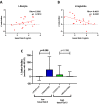Effects of liraglutide vs. lifestyle changes on soluble suppression of tumorigenesis-2 (sST2) and galectin-3 in obese subjects with prediabetes or type 2 diabetes after comparable weight loss
- PMID: 35277168
- PMCID: PMC8917620
- DOI: 10.1186/s12933-022-01469-w
Effects of liraglutide vs. lifestyle changes on soluble suppression of tumorigenesis-2 (sST2) and galectin-3 in obese subjects with prediabetes or type 2 diabetes after comparable weight loss
Abstract
Background: Soluble suppression of tumorigenesis-2 (sST2) and galectin (Gal)-3 are two biomarkers related to inflammation, metabolic disturbances and to myocardial fibrosis that characterize several cardiac pathological conditions. Increased circulating levels of these molecules have been associated with risk of cardiovascular death. Treatment with liraglutide, a glucagon-like peptide 1 analog, is associated with weight loss, improved glycemic control, and reduced cardiovascular risk. We wanted to assess (I) potential differences between subjects with prediabetes or type 2 diabetes mellitus (T2DM) and healthy controls in sST2 and Gal-3 circulating levels, and their relationship with glycemic control and markers of beta cell function and myocardial injury; (II) whether liraglutide treatment modulates these markers in subjects with prediabetes or early T2DM independently of weight loss; (III) whether baseline levels of any of these two molecules may predict the response to liraglutide treatment.
Methods: Forty metformin-treated obese subjects (BMI ≥ 30) with prediabetes [impaired fasting glucose (IFG) or impaired glucose tolerance (IGT) or both (n = 23)] or newly diagnosed T2DM (n = 17), were randomized to liraglutide or lifestyle counseling until achieving a comparable weight loss (7% of initial body weight). Thirteen subjects were enrolled as healthy controls for baseline sST2 and Gal-3 levels.
Results: Baseline sST2 levels were comparable between controls and obese patients (p = 0.79) whereas Gal-3 levels were significantly higher in patients as compared to controls (p < 0.001). Liraglutide treatment, but not weight loss achieved by lifestyle counseling, decreased plasma sST2 levels (- 9%, beta = - 14.9, standard deviation 6.9, p = 0.037) while Gal-3 levels did not change. A reduction in serum hs-Troponin I was observed after intervention, due to a 19% (p = 0.29) increase in the lifestyle arm, and a 25% decrease (p = 0.033) in the liraglutide arm (between-group difference p = 0.083). Lower baseline Gal-3 levels predicted a better improvement in beta cell function after liraglutide treatment.
Conclusions: Liraglutide-induced reduction in sST2 and possibly hs-TnI suggests that in obese patients with prediabetes or early T2DM this drug may have a positive effect on (cardiac) fibrosis, whereas plasma level of Gal-3 before liraglutide initiation may predict response to the drug in terms of beta cell function improvement. Trial registration Eudract: 2013-001356-36.
Keywords: Cardiac fibrosis; Diabetes; Gal-3; Liraglutide; Markers; sST2.
© 2022. The Author(s).
Conflict of interest statement
The authors declare that they have no competing interests.
Figures






Similar articles
-
Liraglutide and not lifestyle intervention reduces soluble CD163 after comparable weight loss in obese participants with prediabetes or type 2 diabetes mellitus.Cardiovasc Diabetol. 2024 Apr 29;23(1):146. doi: 10.1186/s12933-024-02237-8. Cardiovasc Diabetol. 2024. PMID: 38685051 Free PMC article.
-
Effects of Liraglutide on Weight Loss, Fat Distribution, and β-Cell Function in Obese Subjects With Prediabetes or Early Type 2 Diabetes.Diabetes Care. 2017 Nov;40(11):1556-1564. doi: 10.2337/dc17-0589. Epub 2017 Sep 14. Diabetes Care. 2017. PMID: 28912305 Clinical Trial.
-
Thromboxane-Dependent Platelet Activation in Obese Subjects with Prediabetes or Early Type 2 Diabetes: Effects of Liraglutide- or Lifestyle Changes-Induced Weight Loss.Nutrients. 2018 Dec 2;10(12):1872. doi: 10.3390/nu10121872. Nutrients. 2018. PMID: 30513818 Free PMC article. Clinical Trial.
-
What are the pharmacotherapy options for treating prediabetes?Expert Opin Pharmacother. 2014 Oct;15(14):2003-18. doi: 10.1517/14656566.2014.944160. Epub 2014 Aug 19. Expert Opin Pharmacother. 2014. PMID: 25139488 Review.
-
Current and Emerging Pharmacotherapies for Weight Management in Prediabetes and Diabetes.Can J Diabetes. 2015 Dec;39 Suppl 5:S134-41. doi: 10.1016/j.jcjd.2015.10.001. Can J Diabetes. 2015. PMID: 26654857 Review.
Cited by
-
Interleukin-1β in circulating mononuclear cells predicts steatotic liver disease improvement after weight loss in subjects with obesity and prediabetes or type 2 diabetes.Cardiovasc Diabetol. 2025 Jun 13;24(1):247. doi: 10.1186/s12933-025-02706-8. Cardiovasc Diabetol. 2025. PMID: 40514652 Free PMC article. Clinical Trial.
-
Predictive role of serum sST2 for heart failure in children with severe pneumonia.Eur J Med Res. 2025 Jul 8;30(1):593. doi: 10.1186/s40001-025-02874-z. Eur J Med Res. 2025. PMID: 40624531 Free PMC article.
-
Liraglutide and not lifestyle intervention reduces soluble CD163 after comparable weight loss in obese participants with prediabetes or type 2 diabetes mellitus.Cardiovasc Diabetol. 2024 Apr 29;23(1):146. doi: 10.1186/s12933-024-02237-8. Cardiovasc Diabetol. 2024. PMID: 38685051 Free PMC article.
-
Liraglutide improves adipose tissue remodeling and mitochondrial dynamics in a visceral obesity model induced by a high-fat diet.Curr Res Pharmacol Drug Discov. 2024 May 23;6:100185. doi: 10.1016/j.crphar.2024.100185. eCollection 2024. Curr Res Pharmacol Drug Discov. 2024. PMID: 38846009 Free PMC article.
-
Pharmacological Support for the Treatment of Obesity-Present and Future.Healthcare (Basel). 2023 Feb 2;11(3):433. doi: 10.3390/healthcare11030433. Healthcare (Basel). 2023. PMID: 36767008 Free PMC article. Review.
References
-
- Bayes-Genis A, De Antonio M, Vila J, Peñafiel J, Galán A, Barallat J, Zamora E, Urrutia A, Lupón J. Head-to-head comparison of 2 myocardial fibrosis biomarkers for long-term heart failure risk stratification: ST2 versus galectin-3. J Am Coll Cardiol. 2014;63:158–166. doi: 10.1016/j.jacc.2013.07.087. - DOI - PubMed
-
- Martínez-Martínez E, Brugnolaro C, Ibarrola J, Ravassa S, Buonafine M, López B, Fernández-Celis A, Querejeta R, Santamaria E, Fernández-Irigoyen J, et al. CT-1 (cardiotrophin-1)-Gal-3 (galectin-3) axis in cardiac fibrosis and inflammation: mechanistic insights and clinical implications. Hypertension. 2019;73:602–611. doi: 10.1161/HYPERTENSIONAHA.118.11874. - DOI - PubMed
Publication types
MeSH terms
Substances
LinkOut - more resources
Full Text Sources
Medical

